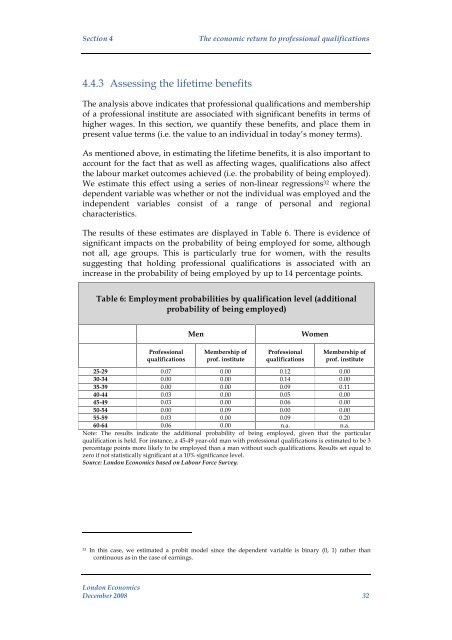Economic impact assessment of the CCPMO: Final report - CIPD
Economic impact assessment of the CCPMO: Final report - CIPD
Economic impact assessment of the CCPMO: Final report - CIPD
Create successful ePaper yourself
Turn your PDF publications into a flip-book with our unique Google optimized e-Paper software.
Section 4<br />
The economic return to pr<strong>of</strong>essional qualifications<br />
4.4.3 Assessing <strong>the</strong> lifetime benefits<br />
The analysis above indicates that pr<strong>of</strong>essional qualifications and membership<br />
<strong>of</strong> a pr<strong>of</strong>essional institute are associated with significant benefits in terms <strong>of</strong><br />
higher wages. In this section, we quantify <strong>the</strong>se benefits, and place <strong>the</strong>m in<br />
present value terms (i.e. <strong>the</strong> value to an individual in today’s money terms).<br />
As mentioned above, in estimating <strong>the</strong> lifetime benefits, it is also important to<br />
account for <strong>the</strong> fact that as well as affecting wages, qualifications also affect<br />
<strong>the</strong> labour market outcomes achieved (i.e. <strong>the</strong> probability <strong>of</strong> being employed).<br />
We estimate this effect using a series <strong>of</strong> non-linear regressions 32 where <strong>the</strong><br />
dependent variable was whe<strong>the</strong>r or not <strong>the</strong> individual was employed and <strong>the</strong><br />
independent variables consist <strong>of</strong> a range <strong>of</strong> personal and regional<br />
characteristics.<br />
The results <strong>of</strong> <strong>the</strong>se estimates are displayed in Table 6. There is evidence <strong>of</strong><br />
significant <strong>impact</strong>s on <strong>the</strong> probability <strong>of</strong> being employed for some, although<br />
not all, age groups. This is particularly true for women, with <strong>the</strong> results<br />
suggesting that holding pr<strong>of</strong>essional qualifications is associated with an<br />
increase in <strong>the</strong> probability <strong>of</strong> being employed by up to 14 percentage points.<br />
Table 6: Employment probabilities by qualification level (additional<br />
probability <strong>of</strong> being employed)<br />
Men<br />
Women<br />
Pr<strong>of</strong>essional<br />
qualifications<br />
Membership <strong>of</strong><br />
pr<strong>of</strong>. institute<br />
Pr<strong>of</strong>essional<br />
qualifications<br />
Membership <strong>of</strong><br />
pr<strong>of</strong>. institute<br />
25-29 0.07 0.00 0.12 0.00<br />
30-34 0.00 0.00 0.14 0.00<br />
35-39 0.00 0.00 0.09 0.11<br />
40-44 0.03 0.00 0.05 0.00<br />
45-49 0.03 0.00 0.06 0.00<br />
50-54 0.00 0.09 0.00 0.00<br />
55-59 0.03 0.00 0.09 0.20<br />
60-64 0.06 0.00 n.a. n.a.<br />
Note: The results indicate <strong>the</strong> additional probability <strong>of</strong> being employed, given that <strong>the</strong> particular<br />
qualification is held. For instance, a 45-49 year-old man with pr<strong>of</strong>essional qualifications is estimated to be 3<br />
percentage points more likely to be employed than a man without such qualifications. Results set equal to<br />
zero if not statistically significant at a 10% significance level.<br />
Source: London <strong>Economic</strong>s based on Labour Force Survey.<br />
32<br />
In this case, we estimated a probit model since <strong>the</strong> dependent variable is binary (0, 1) ra<strong>the</strong>r than<br />
continuous as in <strong>the</strong> case <strong>of</strong> earnings.<br />
London <strong>Economic</strong>s<br />
December 2008 32

















